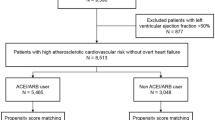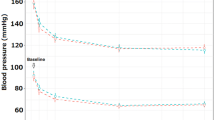Summary
Angiotensin-converting enzyme (ACE) inhibitor therapy has been associated with a substantial (≥20%) reduction in the risk of major ischemic events in two recent clinical trials with long-term follow-up: Studies of Left Ventricular Dysfunction (SOLVD) and the Survival and Ventricular Enlargement (SAVE) study. Participants in these studies included patients with a low ejection fraction (≤0.35 in SOLVD and ≤0.40 in SAVE), generally without symptoms of congestive heart failure. Approximately 80% of patients enrolled in SOLVD and all participants in SAVE had histories of ischemic heart disease or acute myocardial infarction (SAVE). In both SOLVD and SAVE the risk of experiencing a major ischemic event such as myocardial infarction was reduced significantly following prolonged ACE inhibitor therapy. In the SOLVD trial, this effect was evident across a range of patient subgroups, including varying concomitant drug therapies. In both studies, several months elapsed before this benefit became apparent, suggesting an effect on underlying ischemic pathophysiology. A third trial of ACE inhibitor therapy postinfarction, the Acute Infarction Ramipril Efficacy (AIRE) Study, demonstrated a 27% reduction in all cause mortality but no effect on myocardial infarction after a 15-month mean follow-up. No effect of ACE inhibition on risk of survival or reinfarction was reported in the Cooperative New Scandinavian Enalapril Survival Study (CONSENSUS-II), which began the drug within 24 hours of infarction and terminated follow-up at 6 months, a time not likely to demonstrate infarction reduction benefit based on the SOLVD and SAVE observations. Neither AIRE nor CONSENSUS-II had objectively determined left ventricular dysfunction as an entry criterion, as did SOLVD and SAVE, but AIRE mandated “clinical” congestive heart failure prior to randomization. More recently, preliminary results from the third Gruppo Italiano per lo Studio della Sopravvivenza nell'Infarto Miocardico (GISSI-3), the Fourth International Study of Infarct Survival (ISIS-4), and the Chinese Captopril Trial suggested that angiotensin-converting enzyme (ACE) inhibitor mortality benefits post-myocardial infarction would be detected in these megatrials as early as 35 days after the event. The mechanism of ACE inhibitor benefit is likely multifactorial and linked to a variety of cardiac and vascular protective mechanisms currently being elucidated. Additional trials are required to ascertain if ACE inhibitors might effect similar benefits in other high-risk populations, such as patients with hypertension or diabetes alone, and to determine if this is a drug class effect or is specific to individual medications studied.
Similar content being viewed by others
References
American Heart Association.1991 Heart and Stroke Facts. Dallas, TX: The American Heart Association, 1991.
The SOLVD Investigators. Studies of Left Ventricular Dysfunction (SOLVD)—Rationale, design and methods: Two trials that evaluate the effect of enalapril in patients with reduced ejection fraction.Am J Cardiol 1990;66:315–322.
The SOLVD Investigators. Effects of enalapril on survival in patients with reduced left ventricular ejection fractions and congestive heart failure.N Engl J Med 1991;325:293–302.
The SOLVD Investigators. Effect of enalapril on mortality and the development of heart failure in asymptomatic patients with reduced left ventricular ejection fractions.N Engl J Med 1992;327:685–691.
Moyé LA, Pfeffer MA, Braunwald E. Rationale, design and baseline characteristics of the survival and ventricular enlargement trial.Am J Cardiol 1991;68:70D-79D.
Pfeffer MA, Braunwald E, Moyé LA, et al. Effect of captopril on mortality and morbidity in patients with left ventricular dysfunction after myocardial infarction.N Engl J Med 1992;327:668–677.
Swedberg K, Held P, Kjekshus J, Rasmussen K, Ryden L, Wedel H, on behalf of the CONSENSUS-II Study Group. Effects of the early administration of enalapril on mortality in patients with acute myocardial infarction. Results of the Cooperative New Scandinavian Enalapril Survival Study II (CONSENSUS-II).N Engl J Med 1992;327:678–684.
The Acute Infarction Ramipril Efficacy (AIRE) Study Investigators. Effect of ramipril on mortality and morbidity of survivors of acute myocardial infarctions with clinical evidence of heart failure.Lancet 1993;342:821–828.
The CONSENSUS Trial Study Group. Effects of enalapril on mortality in severe congestive heart failure.N Engl J Med 1987;316:1429–1435.
Cohn JN, Johnson G, Ziesche S, et al. A comparison of enalapril with hydralazine-isosorbide dinitrate in the treatment of chronic congestive heart failure.N Engl J Med 1991;325:303–310.
Braunwald E. ACE inhibitors—A cornerstone of the treatment of heart failure.N Engl J Med 1991;325:351–353.
Cohn JN. The prevention of heart failure—A new agenda.N Engl J Med 1992;327:725–727.
Yusuf S, Pepine CJ, Garces C, et al. Effect of enalapril on myocardial infarction and unstable angina in patients with low ejection fraction.Lancet 1992;340:1173–1178.
Bonarjee VVS, Carstensen S, Caidahl K, Nilsen DWT, Edner M, Berning J (CONSENSUS-II Multi-Echo Study Group). Attenuation of left ventricular dilatation after acute myocardial infarction by early initiation of enalapril therapy.Am J Cardiol 1993;72:1004–1009.
ISIS Collaborative Group. Randomized study of oral captopril in over 50,000 patients with suspected acute myocardial infarction.Circulation 1993;88:4(Part 2):I394.
GISSI Collaborative Group. Oral presentation at the 66th Scientific Session of the American Heart Association, November, 1993, Atlanta, Georgia.
The Chinese Captopril Trial. Oral presentation at the 66th Scientific Session of the American Heart Association, November, 1993, Atlanta, Georgia.
Hall AS, Winter C, Bogle SM, Mackintosh AF, Murray GD, Ball SG. The Acute Infarction Ramipril Efficacy (AIRE) Study: Rationale, design, organization, and outcome definitions.J Cardiovasc Pharmacol 1991;18(Suppl 2):S105–109.
Greene HL, Richardson DW, Hallstrom AP, et al. Congestive heart failure after acute myocardial infarction in patients receiving antiarrhythmic agents for ventricular premature complexes (Cardiac Arrhythmia Suppression Study).Am J Cardiol 1989;63:393–398.
Richard DP, Benedict CR, Kronenberg MW, et al. for the SOLVD Investigators. Effects of long-term enalapril on adrenergic activity and sensitivity during exercise in patients with left ventricular dysfunction.Circulation 1993;88(Suppl II):I-293.
Goldsmith SR, Haskins GJ, Miller E. Angiotensin II and sympathetic activity in patients with congestive heart failure.J Am Coll Cardiol 1993;21:1107–1113.
Beta-Blocker Heart Attack Trial Group. A randomized trial of propranolol in patients with acute myocardial infarction. II. Morbidity Results.JAMA 1983;250:2814–2819.
Hampton JR. Secondary prevention of acute myocardial infarction with beta-blocking agents and calcium antagonists.Am J Cardiol 1990;66:3C-8C.
Deedwania PC, Carbajal EV. Secondary prevention after myocardial infarction. Too many choices, which ones work?Arch Intern Med 1993;153:285–288.
Ganley CJ, Hung HMJ, Temple R. More on the survival and ventricular enlargement trial [letter to editor],N Engl J Med 1993;329:1204–1205.
Pfeffer MA, Myoe LA, Rutherford J, Braunwald E. More on the survival and ventricular enlargement trial [letter to editor],N Engl J Med 1993;329:1205–1206.
Faxon DE, Creager MA, Halperin JL, Sussman HF, Gavras H, Ryan TJ. The effect of angiotensin-converting enzyme inhibition on coronary blood flow and hemodynamics in patients without coronary artery disease.Int J Cardiol 1982;2:251–262.
Gibbs JSR, Crean PA, Mackus L, Wright C, Sutton G, Fox KM. The variable effects of angiotensin-converting enzyme inhibition on myocardial ischaemia in chronic stable angina.Br Heart J 1989;62:112–117.
Kaski JC, Rosano G, Gavrielides S, Chen L. Effects of angiotensin-converting enzyme inhibition on exercise induced angina and ST segment depression in patients with microvascular angina.J Am Coll Cardiol 1994;23:652–657.
Konstam MA, Rousseau MF, Kronenberg MW, et al. Effects of the angiotensin converting enzyme inhibitor enalapril on the long-term progression of left ventricular function in patients with heart disease.Circulation 1992;86:431–438.
Konstam MA, Kronenberg MW, Rousseau MF, et al. Effects of the angiotensin converting enzyme inhibitor enalapril on long-term progression of left ventricular dilatation in patients with asymptomatic systolic dysfunction.Circulation 1993;88(Part I):2277–2283.
McMahon S, Peto R, Cutler J, et al. Blood pressure, stroke, and coronary heart disease: Part 1, prolonged differences in blood pressure: Prospective observational studies corrected for the regression dilution bias.Lancet 1990;335:765–774.
Collins R, Peto R, MacMahon S, et al. Blood pressure, stroke, and coronary heart disease. Part 2: Short-term reductions in blood pressure: Overview of randomized drug trials in their epidemiological context.Lancet 1990;335:827–838.
Kiowski W, Zuber M, Elsasser S, Erne P, Pfisterer M, Burkart F. Coronary vasodilatation and improved myocardial lactate metabolism after angiotensin converting enzyme inhibition with enalapril in patients with congestive heart failure.Am Heart J 1991;122:1382–1388.
Anonymous. From cardiac to vascular protection: The next chapter [editorial].Lancet 1992;340:1197–1198.
Frolich ED, Chobanian AV, Devereux RB, et al. The heart in hypertension.N Engl J Med 1992;327:998–1008.
Heagerty AM. Angiotensin-II: Vasoconstrictor or growth factor?J Cardiovasc Pharmacol 1991;18(Suppl 2):S14-S19.
Doyle AE. ACE inhibition: Benefits beyond blood pressure control.Am J Med 1992;92(Suppl 4B):1S-2S.
Francis GS. Neuroendocrine activity in heart failure.Am J Cardiol 1990;66(Suppl D):33D-38D.
Vannan MA, Taylor DJE. Ventricular remodelling after myocardial infarction [editorial].Br Heart J 1992;68:257–259.
Smith EB. The pathogenesis of atherosclerosis. In: Julian DG, Camm AJ, Fox KM, Hall RJC, Poole-Wilson PA, eds.Diseases of the Heart. London: Bailliere Tindall, 1989:1035–1066.
Francis GS, Benedict C, Johnstone DE, et al., for the SOLVD Investigators. Comparison of neuroendocrine activation in patients with left ventricular dysfunction with and without congestive heart failure. A substudy of the Studies of Left Ventricular Dysfunction (SOLVD).Circulation 1990;82:1724–1729.
Swedberg K, Eneroth P, Kjekshus J, Wilhelmsen L, for the CONSENSUS Trial Study Group. Hormones regulating cardiovascular function in patients with severe heart failure and their relation to mortality.Circulation 1990;82:1730–1736.
Waeber B, Nussberger J, Brunner HR. Angiotensin-converting-enzyme inhibitors in hypertension. In: Laragh JH, Brenner BM, eds.Hypertension: Pathophysiology, Diagnosis and Management. New York: Raven Press, 1990:2209–2232.
Cambien F, Poirier O, Lecerf L, et al. Deletion polymorphism in the gene for angiotensin-converting enzyme is a potent risk factor for myocardial infarction.Nature 1992;359:641–644.
Tiret L, Kee F, Poirier O, et al. Deletion polymorphism in angiotensin-converting enzyme gene associated with parental history of myocardial infarction.Lancet 1993;341:991–92.
Raynolds MV, Bristow MR, Bush EW, et al. Angiotensin-converting enzyme DD genotype in patients with ischemic or dilated cardiomyopathy.Lancet 1993;324:1073–1075.
Marian AJ, Yu QT, Workman R, Greve G, Roberts R. Angiotensin-converting enzyme polymorphism in hypertrophic cardiomyopathy and sudden cardiac death.Lancet 1993;342:1085–1086.
Chobanian AV. The effects of ACE inhibitors and other antihypertensive drugs in cardiovascular risk factors and atherogenesis.Clin Cardiol 1990;13:VII41–48.
Chobanian AV, Haudenschild CC, Nickerson C, Drago R. Antiatherogenic effect of captopril in the Watanabe heritable hyperlipidemic rabbit.Hypertension 1990;15:327–331.
Aberg G, Ferrer P. Effects of captopril on atherosclerosis in cynomolgus monkeys.J Cardiovasc Pharmacol 1990;15:S65-S72.
Ridker PM, Gaboury CL, Conlin PR, Seely EW, Williams GH, Vaughn DE. Stimulation of plasminogen activator inhibitor in vivo by infusion of angiotensin II. Evidence of a potential interaction between the renin-angiotensin system and fibrolytic function.Circulation 1993;87:1969–1973.
James IM, Dickenson EJ, Burgoyne W, et al. Treatment of hypertension with captopril; preservation of regional blood flow and reduced platelet aggregation.J Hum Hypertens 1988;2:21–25.
Someya N, Morotomi Y, Kodama K, et al. Suppressive effects of captopril on platelet aggregation in essential hypertension.J Cardiovasc Pharmacol 1984;6:840–843.
Alderman MH, Madhavan S, Ooi WL, Cohen PH, Sealey JE, Laragh JH. Association of the renin-sodium profile with the risk of myocardial infarction in patients with hypertension.N Engl J Med 1991;324:1098–1104.
Laragh JH. A decade of angiotensin-converting enzyme (ACE) inhibition.Am J Med 1992;92(Suppl 4B):3S-7S.
Meade TW, Cooper JA, Peart WS. Plasma renin activity and ischemic heart disease.N Engl J Med 1993;329:616–619.
Dzau VJ. Renin and myocardial infarction in hypertension.N Engl J Med 1991;324:1128–1130.
Goldbourt U, Behar S, Reicher-Reiss H, Zion M, Mandelzweig L, Kaplinsky E, for the SPRINT Study Group. Early administration of nifedipine in suspected acute myocardial infarction.Arch Intern Med 1993;153:345–353.
The Israeli SPRINT Study Group. The Secondary Prevention Israeli Nifedipine Trial (SPRINT): A randomized intervention trial of nifedipine in patients with acute myocardial infarction.Eur Heart J 1989;9:354–364.
The Multicenter Diltiazem Postinfarction Trial Research Group. The effect of diltiazem on mortality and reinfarction after myocardial infarction.N Engl J Med 1988;319:385–392.
Hall D, Zeitler H, Rudolph W. Counteraction of the vasodilator effects of enalapril by aspirin in severe heart failure.J Am Coll Cardiol 1992;20:1549–1555.
Parameshwar J, Poole-Wilson PA. The role of calcium antagonists in the treatment of chronic heart failure.Euro Heart J 1993;14(Suppl A):38–44.
Elkayam U, Shotan A, Mehra A, Osterzega E. Calcium channel blockers and heart failure.J Am Coll Cardiol 1993;22(Suppl A):139A-144A.
Conti CR. Use of calcium antagonists to treat heart failure.Clin Cardiol 1994;17:101–102.
Author information
Authors and Affiliations
Rights and permissions
About this article
Cite this article
Young, J.B. Reduction of ischemic events with angiotensin-converting enzyme inhibitors: Lessons and controversy emerging from recent clinical trials. Cardiovasc Drug Ther 9, 89–102 (1995). https://doi.org/10.1007/BF00877749
Received:
Accepted:
Issue Date:
DOI: https://doi.org/10.1007/BF00877749




